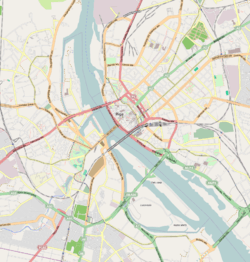House of the Livonian Noble Corporation
| House of the Livonian Noble Corporation | |
|---|---|
|
Corner of Jēkaba and Klostera Streets, Riga. | |
 | |
| General information | |
| Town or city | Riga |
| Country | Latvia |
| Coordinates | 56°57′4″N 24°6′16″E / 56.95111°N 24.10444°ECoordinates: 56°57′4″N 24°6′16″E / 56.95111°N 24.10444°E |
| Construction started | 1863 |
| Completed | 1867 |
| Renovated | 1922 |
| Design and construction | |
| Architect | Robert Pflug, Jānis Baumanis |
| Renovating team | |
| Architect | Eižens Laube |
The House of the Livonian Noble Corporation (Latvian: Vidzemes bruņniecības nams) is a historical building in Riga, Latvia, constructed to house the Landtag of the Livonian Noble Corporation in the Governorate of Livonia. It was opened in 1867 and housed the Landtag until Latvian independence in 1919, and was subsequently damaged by fire in 1921. Today it is home to the Saeima, the parliament of Latvia. It is located in UNESCO listed Old Riga, directly opposite St. James's Cathedral.
History of the building
Construction of the building began at a time when parts of present-day Latvia were administered by the Russian Empire as the Governorate of Livonia, which included present-day northern Latvia and a large part of southern Estonia. The Livonian Noble Corporation was a semi-autonomous fiefdom that administered the area on behalf of the Emperor. The Noble Corporation also known as the "knighthood" began at the dissolution of the Teutonic Order in the 16th century, and comprised the Baltic-German nobility who made up the ruling class in Latvia and Estonia until the First World War. The Landtag was not a democratic body, but was rather an aristocratic assembly of Nobles.
Construction began in 1863 and was designed by Robert Pflug, a Baltic-German, and Jānis Baumanis, the first academically trained Latvian architect.[1] The exterior and interior were finished in Eclectic style. The façade featured a niche containing a statue by Danish sculptor David Jensen of the Teutonic Landmeister Wolter von Plettenberg.
Latvian Independence
After the People’s Council declared Latvian independence on 18 November 1918, the building served as it's home, then in 1919, was home to the All-Latvian Congress of Workers' Soviet Deputies while the Latvian Socialist Soviet Republic controlled the capital. After the Socialist republic had been defeated, the building was the seat of the Constitutional Assembly elected in 1920. On 17 October 1921, the building was destroyed by fire. It was restored according to the design of the architect Eižens Laube. The restoration included a new statue by sculptor Rihards Maurs of Lāčplēsis the "bear-slayer", from the Latvian epic of the same name, replacing the statue of von Plettenberg which was destroyed in the fire. At the time of the building's restoration the main assembly hall was modified to meet the needs of the Saeima of the new Republic of Latvia. The Saeima chamber today still approximates this design. The last meeting of the Constitutional Assembly, which wrote the Constitution of Latvia took place in the restored building on 3 November 1922.
Authoritarian Régime
The building served as the home of the Saeima until a Self-coup by serving Prime Minister Kārlis Ulmanis in 1934. Ulmanis assumed the title of President in 1936 and the building served as the centre of his Authoritarian régime.
Occupation
During the Second World War, after Latvia was occupied, the building was the location of the Supreme Council of the Latvian SSR under the Soviets and the headquarters of the SS and police for the Eastern territories under Nazi Germany. Latvia remained under Soviet occupation after the war and the building served as the location of the Supreme Council for almost half a century. In the early 1980s one of the inner courtyards was walled in to expand building space, this part of the building is now known as the Voting Room.
Restoration of Independence
After the Restoration of independence 4 May 1990 the building was home to the Supreme Council of the Republic of Latvia, which functioned as an interim parliament while the Constitution was re-established. Since 1993, it is once again home to the Saeima.
-
.jpg)
Saeima chamber
-
.jpg)
Yellow Room
-
.jpg)
Red Room
-
.jpg)
White Room
-
.jpg)
Voting Room
-

Brown Room
-

Grand Staircase
-
.jpg)
Main entrance on Klostera Street
-
.jpg)
Klostera Street and St. James's Cathedral
-
.jpg)
Building in Winter
-

View along Jēkaba Street
-

Statue of Lāčplēsis. Destroyed circa 1950s, restored 2007.
See also
References
- ↑ "Main building of the Saeima". 2014. Retrieved 18 December 2014.
External links
| Wikimedia Commons has media related to Main building of the Saeima. |
| ||||||||||||||||||||||||||||||||||||
.jpg)
